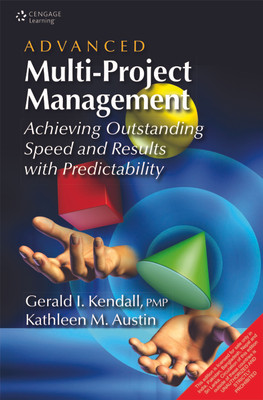Advanced Multi-Project Management 1st Edition(English, Paperback, Kendall Gerald I.)
Quick Overview
Product Price Comparison
Even in a well-managed multi-project environment, it is not unusual to see half of all projects completed either late, over budget or with cuts to original scope. However, the proven approach presented in Advanced Multi-Project Management has enabled large, medium, and even small organizations to consistently complete their projects faster, within original scope and budget, and increase the number of projects executed with the same resources by as much as 70%. The list of companies that have used this methodology for stunning results includes some of the biggest, well-known names in the world-Boeing, Rio Tinto, ABB, and Chrysler. This guide details the six gears that must work in unison to drive speed and predictability within an organization. Salient Features Presents the full strategy and detailed tactics to transform any multi-project environment, including how to speed up and synchronize multiple projects correctly with the same resources and delivering projects on time, on budget, and within the original scope Helps firms consistently generate over 50% more project throughput Outlines the 10 essential steps needed to create valid project networks and task estimates in a multi-project environment Illustrates examples of how to define resource skill sets in a multi-project environment and effective ways to align all projects to prevent constant conflicts over resources Explains the five most common bad practices in project management today-from defining tasks at too great a level of detail to allowing stage gate systems and approvals to slow down projects Reveals software requirements necessary to support small, medium, and large multi-project environments. About the Author Gerald I. Kendall, PMP, Principal, TOC International, is a distinguished thought-leader, noted management consultant, sought-after speaker, best-selling author, and recognized expert at program management and project portfolio management, supply chain logistics, and strategic planning, with extensive implementation experience around the world since 1968. He is an active member of the Project Management Institute and the author of numerous articles and four books including the best-selling Advanced Project Portfolio Management and the PMO. Kathleen M. Austin, Principal, APT Concepts, is a published author globally recognized for her 20 plus years of work in Theory of Constraints and integrated TOC Lean-Six Sigma implementations. She has also been involved in the instruction, development, coaching and mentoring within strategic planning, project/portfolio management, supply chain management, and software development. Kathleen served over 12 years in the US Air Force as an acquisition project manager and manufacturing manager for radar, missile, and aircraft programs. Ms. Austin earned a BSBA degree from the University of Nebraska and her Masters Degree in Logistics Management from the Air Force Institute of Technology. Table of Contents Part I-Why Multi-Project Environments Are So Messed Up Chapter 1: Introduction-The Multi-Project Problem Chapter 2: Resource Conflicts Chapter 3: Poorly Defined Project Networks Chapter 4: The Biggest Leverage Point for Improving Part II-Overview Of The Permanent Multi-Project Solution Chapter 5: Project Networks Chapter 6: Strategic Buffering-Insulating Projects from Variability Chapter 7: Controlled Project WIP-Aligning and Activating Multiple Projects Chapter 8: Fast Execution, Single Priority System, Recovery Chapter 9: Enterprise Resource Planning Chapter 10: Multi-Project Software Requirements Chapter 11: What Is It All Worth? Part III-Project Planning, Networks, And Risk Avoidance Chapter 12: Level of Detail-Not the Lowest Level Chapter 13: Step 1-The Projects Measurable Goals, Tangible Scope, and Sponsor Criteria Chapter 14: Step 2-The Backbone Chapter 15: Step 3-The Skeleton Chapter 16: Step 4-Additional Dependencies-First Risk Avoidance Chapter 17: Step 5-Checking Against Project Goals and Scope-Second Risk Avoidance Chapter 18: Step 6-Resourcing Chapter 19: Step 7-Expert Scrutiny-Third Risk Avoidance Chapter 20: Step 8-Time estimates-Fourth Risk Avoidance Chapter 21: Step 9-Duration Reduction without Compromise Chapter 22: Step 10-Final Project Risk Assessment-Fifth Risk Avoidance Part IV-Insulating Projects From Variability Chapter 23: Three Points of Network Insulation Chapter 24: Operations versus Project Responsibility-Resource Insulation Chapter 25: Project-to-Project Insulation Chapter 26: Common Cause versus Special Cause Insulation Part V-Aligning And Activating Multiple Projects Chapter 27: Setting Project Priorities Chapter 28: Two Different Ways to Align Multiple Projects Chapter 29: What If Analyses on Timelines and Resources Chapter 30: Finalizing the Project Schedule and Activation Part VI-Multi-Project Execution Chapter 31: Project Manager Execution Roles Chapter 32: Resource Manager Execution Roles Chapter 33: Senior Management Execution Role-Daily Fast-Track Meetings Chapter 34: Senior Management Execution Role-Full-Kitting Projects Chapter 35: Senior Management in Stage Gate -How to Avoid the Huge Damage Chapter 36: Senior Management Execution Role-Portfolio Review Process Part VII-Enterprise Project Resource Planning Chapter 37: Distinguishing between Temporary Bottlenecks and Need to Hire/Contract Chapter 38: Supervisor and Management Loads Chapter 39: Increasing Load on Operations from Project Completion Chapter 40: Short-, Medium-, and Long-Term Challenges Part VIII-Multi-Project Software Requirements Chapter 41: Software Planning Requirements-Buffers, Global Resources, and Alignment Chapter 42: Software Execution Requirements-Buffer Penetration and Project and Resource Trends Chapter 43: Role-Based Software Views Part IX-Executive Buy-In And Conclusions Chapter 44: Executive Buy-In Chapter 45: Conclusions Appendix A: Strategy and Tactics Approach For Multi-Project Management Appendix B: Success Stories and Video References Appendix C: Sample Enterprise Resource Categories Appendix D: What About Agile? Appendix E: Detailed Case Study on Project Planning References Index


